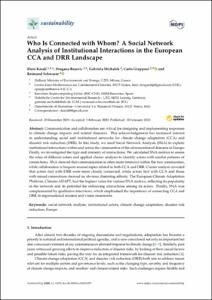Mostra el registre d'ítem simple
Who is connected with whom? A social network analysis of institutional interactions in the european CCA and DRR landscape
| dc.contributor.author | Karali, Eleni |
| dc.contributor.author | Bojovic, Dragana |
| dc.contributor.author | Michaleck, Gabriela |
| dc.contributor.author | Giupponi, Carlo |
| dc.contributor.author | Schwarze, Reimund |
| dc.contributor.other | Barcelona Supercomputing Center |
| dc.date.accessioned | 2020-05-08T17:35:12Z |
| dc.date.available | 2020-05-08T17:35:12Z |
| dc.date.issued | 2020 |
| dc.identifier.citation | Karali, E. [et al.]. Who is connected with whom? A social network analysis of institutional interactions in the european CCA and DRR landscape. "Sustainability", 2020, vol. 12, núm. 3, 1275. |
| dc.identifier.issn | 2071-1050 |
| dc.identifier.uri | http://hdl.handle.net/2117/186903 |
| dc.description.abstract | Communication and collaboration are critical for designing and implementing responses to climate change impacts and related disasters. This acknowledgement has increased interest in understanding social and institutional networks for climate change adaptation (CCA) and disaster risk reduction (DRR). In this study, we used Social Network Analysis (SNA) to explore institutional interactions within and across the communities of the aforementioned domains in Europe. Firstly, we investigated the type and intensity of interactions. We calculated SNA metrics to assess the roles of different actors and applied cluster analysis to identify actors with similar patterns of connections. SNA showed that communication is often more intensive within the two communities, while collaboration is frequent around topics related to both CCA and DRR. Cluster analysis revealed that actors tied with DRR were more closely connected, while actors tied with CCA and those with mixed connections showed no obvious clustering affinity. The European Climate Adaptation Platform, Climate-ADAPT, had the highest value for various SNA metrics, reflecting its popularity in the network and its potential for enhancing interactions among its actors. Finally, SNA was complemented by qualitative interviews, which emphasised the importance of connecting CCA and DRR in organisational mission and vision statements. |
| dc.description.sponsorship | The research presented in this paper was conducted in the context of the PLACARD project (Grant agreement No. 653255), funded by the European Union’s Horizon 2020 Research & Innovation Framework programme. The project aims at sharing knowledge and enhancing collaboration between the CCA and DRR research, policy and practice communities. |
| dc.language.iso | eng |
| dc.publisher | MDPI |
| dc.rights | Attribution 3.0 Spain |
| dc.rights | Attribution 4.0 International (CC BY 4.0) |
| dc.rights.uri | http://creativecommons.org/licenses/by/3.0/es/ |
| dc.rights.uri | https://creativecommons.org/licenses/by/4.0/ |
| dc.subject | Àrees temàtiques de la UPC::Desenvolupament humà i sostenible::Degradació ambiental::Canvi climàtic |
| dc.subject.lcsh | Climatic changes |
| dc.subject.lcsh | Online social networks |
| dc.subject.lcsh | Paris Agreement (2015 December 12) |
| dc.subject.lcsh | Disaster risk reduction |
| dc.subject.lcsh | Social Network Analysis |
| dc.subject.lcsh | European Climate Adaptation Platform |
| dc.subject.other | Social network analysis |
| dc.subject.other | Institutional actors |
| dc.subject.other | Climate change adaptation |
| dc.subject.other | Disaster risk reduction |
| dc.subject.other | Europe |
| dc.title | Who is connected with whom? A social network analysis of institutional interactions in the european CCA and DRR landscape |
| dc.type | Article |
| dc.subject.lemac | Canvis climàtics |
| dc.subject.lemac | Xarxes socials en línia |
| dc.identifier.doi | 10.3390/su12031275 |
| dc.description.peerreviewed | Peer Reviewed |
| dc.relation.publisherversion | https://www.mdpi.com/2071-1050/12/3/1275/htm |
| dc.rights.access | Open Access |
| dc.description.version | Postprint (published version) |
| local.citation.other | 1275 |
| local.citation.publicationName | Sustainability |
| local.citation.volume | 12 |
| local.citation.number | 3 |
Fitxers d'aquest items
Aquest ítem apareix a les col·leccions següents
-
Articles de revista [390]


